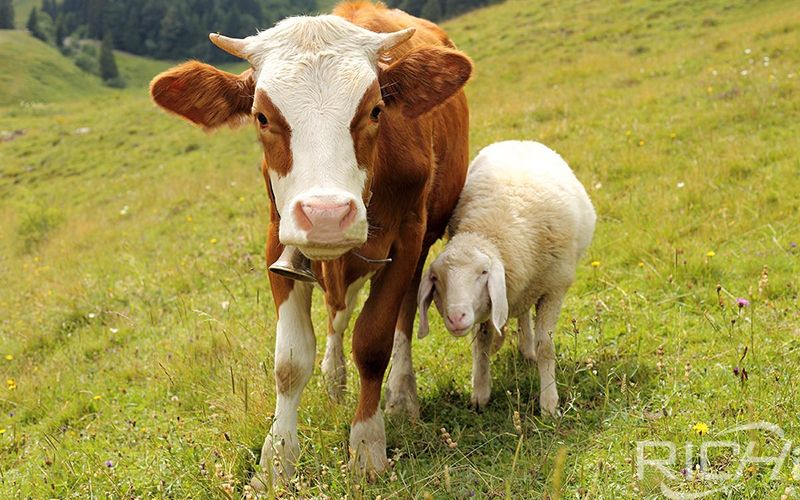
This is where you find all our press releases and news articles.
As the future productive units of a dairy herd, heifers represent a substantial financial investment in feed and labor. This investment needs to be protected by managing and feeding these heifers so that they grow economically and at an optimal rate in order to calve at 24 months of age. The first two to three months of life is a critical period to achieving these objectives.
Many cow-calf producers have become accustomed to using distillers grains as a source of both protein and energy to help meet the nutritional needs of lactating cows from calving until green grass is available. Due to the ongoing distillers shortage, many producers are considering including corn silage in the ration to help alleviate some of the energy shortfall in their hay resources. However, concerns have been expressed that silage in the diet will result in diarrhea or scours in their calves.

Can A Lactating Cow Eat Silage Cause Calf Diarrhea
While this is a critical time for the nursing calf, and producers should be ever vigilant for signs of scours, there are actually a variety of reasons a calf might have a very loose stool and not all of them are cause for concern.
Feeding a diet that is highly digestible and fermented, with a high rate of passage through the digestive system will result in manure that is much more wet and loose than manure from a diet of dry hay and supplemental distillers grains. In dairy cows, a high energy diet has been shown to increase milk production earlier in lactation, and a similar response is likely in beef cows. Increased milk production early in the calf’s life, will also likely result in a looser stool. Additionally, calves begin to nibble at grass and their mother’s feed within a few days of life, and by one month of age, are eating 1% of their body weight on a dry matter basis in feed other than milk. Therefore, they will begin to consume a diet that is responsible for a looser stool just like the cow does. However, dietary related scours do not cause illness and dehydration in the calf.
The health- and life-threatening causes of diarrhea in calves are commonly from a list of infectious pathogens that are shed at low levels by individuals in virtually any group of bovines. Most are viral or protozoal, and some are bacterial. These pathogens are picked up by calves, amplified, and shed at much higher levels into the environment, mainly in feces. Calves born later in the calving season are often born into environments that have much higher levels of these pathogens present than the earliest calves experienced, and as a result, the later-born calves are at higher risk of getting sick. One method that many producers have been successfully implementing in Nebraska for years to break this chain of transmission is called Sandhills Calving. This method involves keeping cow-calf pairs with only calves born in the same one to two week period together until the youngest calves are at least a month old. This prevents amplification of pathogens from continuing to accelerate and provides a fresh start for each one- to two-week cohort of calves.
When cow-calf pairs are in pens in the spring, the calves need a clean, dry place to lie down. Usually, this needs to be somewhere that the cows can’t get into. It needs to be out of the wind. Shelter can be beneficial if the ventilation is adequate. Producers demonstrate a lot of creativity in designing and building simple, cost-effective calf shelters. Sometimes it can be as simple as an electric fence stretched diagonally across the corners of the pen, raised high so calves can go freely underneath, but the cows are fenced out. This allows calves an “escape” where they can lay in some clean dry straw or corn stover.
The best way to judge whether a calf with a loose stool needs treatment is by its attitude and appetite. If it is bright, alert, active and interested in eating, it is likely doing alright. If the calf is listless, moving slowly, ears drooping, and does not appear to be interested in eating or nursing, treatment is likely needed. Fluid replacement is the cornerstone of treatment for scours, though antibiotics may also be necessary in certain situations. A calf that can stand may respond well to treatment with oral electrolytes, but a calf with diarrhea that won’t or can’t stand is very likely in dire need of intravenous fluid therapy. Your veterinarian can help you develop a plan for treating scours in calves if the need arises.
Related Artical
Saudi Arabia 5ton aflfalfa cattle feed and 10ton chicken feed
Cooperate with Uzbekistan customer for 6ton/hour cattle feed line
India and South Africa cattle feed pellet machine prices?
How about straw pellets? Why do cattle and sheep love to eat?
Having the right mix of reliable, high-quality pellet machine and pelletizing systems and expert support is essential to your success. Watch how our end-to-end feed pellet plant solutions have helped our customers optimize their performance.
Our customized and future-proofed turnkey pellet plant solutions is designed with you at the core. From vision to reality and beyond, our team stays connected with yours. Giving you peace-of-mind with an expert at your side.

At RICHI, we go beyond project completion. With RICHI Servicee, we’re your dedicated partners in success. Count on us for expert guidance, minimal downtime, and optimized productivity. Choose RICHI for unmatched service and support.



Meet global product demands and quality standards with industry-leading pellet plant design, engineering, equipment, and construction services for pellet processors.


Your Partner Beyond Project Completion
2000+ cases
RICHI is the leading designer, manufacturer and builder of pellet plants in the world, completing over 2000 projects in 140 countries across 6 continents.
Read More
Increase plant productivity, profitability, and safety by integrating high quality equipment into your pellet production line. Over the years, RICHI has become China's top pellet equipment manufacturer. At the same time, RICHI has established valuable partnerships with the world's leading component and raw material manufacturers to bring you the best there is in technology, automation, and efficiency in pelleting plant machinery.

For nearly 30 years, RICHI has been providing best-in-class pellet plant equipment and services to clients across a variety of industries, sizes, and needs. We pride ourselves on the knowledge and skill that each team member possesses – from our technical sales team to our process design engineers. You can count on RICHI Machinery to take your operation to the next level of innovation, quality, and success.
Need help with your pellet manufacturing plant project? Contact us today.
ANIMAL FEED
BIOMASS
WOOD
ORGANIC FERTILIZER
AQUA FEED
CAT LITTER
MUNICIPAL WASTE RECYCLING
SPECIAL PELLET PRODUCTION
RICHI Machinery continues to deliver world class pellet mill equipment, pellet plant engineering and project solutions that add value to our customers in the animal feed, wood waste, agriculture waste, organic fertilizer, cat litter and special pellet products industries. Throughout the years, we RICHI Machinery have built strong brand, becoming industry-leading pellet machine manufacturer. We value integrity, promise quality, and prioritize your success.
Learn MoreWith our expert team, we precisely implement your process engineering requirements in pellet mill and pelletizing plant systems. No matter which industry you’re in – we understand your needs and deliver solutions that meet the highest standards.
At RICHI, quality comes first. Our pellet making machine and related pellet line equipment undergo rigorous quality controls to ensure they meet the highest standards. Rely on products that are durable, safe, and efficient.
With decades of experience in pellet machine and pellet production line production, we have earned a reputation as a trusted partner in various industries. Our expertise allows us to cover a wide range of applications.
Not only do we offer premium pelleting equipment, but we are also experts at designing, building, installing, and maintaining facilities from the ground up. Our expertise is within pellt plant process design, discovering the most efficient, productive, and profitable way to handle your materials in an end-to-end cycle.

Keeping in touch with us is an effective way to solve all your problems. If you have any needs or questions, please leave your contact information, then RICHI technical consultants will send design, quotation, videos to your mailbox. You can also contact us directly via WhatsApp: +86 13838389622
Copyright©2015-2024 by HENAN RICHI MACHINERY CO., LTD. All rights reserved.